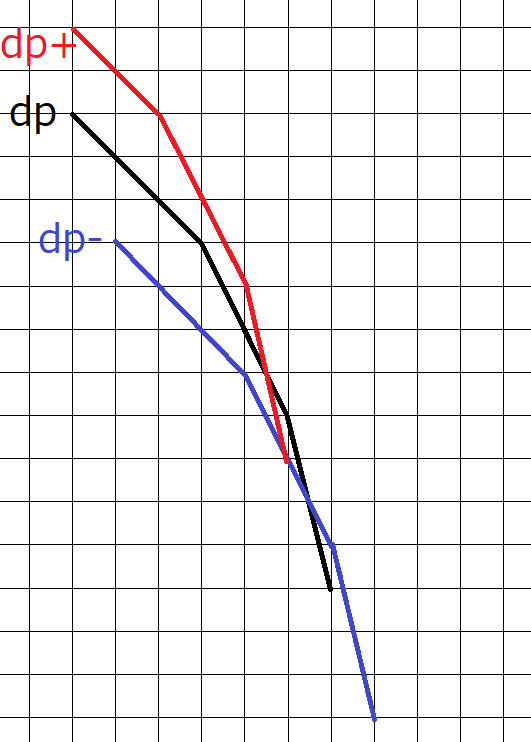G - Stonks Editorial by en_translator
This problem can be solved in an \(O(N^2)\) times with DP (Dynamic Programming) where \(dp[\) the \(i\)-th day has ended \(][\) he possesses \(j\) unit of stock \(]=\{\) maximum amount of money he gains \(\}\). Since there is no use in keeping some stock when on the last day, the answer is \(dp[N][0]\).
Let us observe this DP with Sample 1.
Input of Sample 1:
8 2 5 4 3 7 1 8 6
The DP table where the \(i\)-th row from the top and \((j-1)\)-th column from the left contains \(dp[i][j]\):
0 -2 3 -2 -7 3 -1 -6 -11 3 0 -4 -9 -14 7 3 -2 -7 -14 -21 7 6 2 -3 -8 -15 -22 14 10 5 0 -7 -14 -22 -30 16 11 6 0 -6 -13 -20 -28 -36
We can observe some arithmetic progressions horizontally, so let’s find the differences between adjacent terms.
Here is a table where the \(i\)-th row from the top and \((j-1)\)-th column from the left contains \(dp[i][j-1]-dp[i][j]\):
2 5 5 4 5 5 3 4 5 5 4 5 5 7 7 1 4 5 5 7 7 4 5 5 7 7 8 8 5 5 6 6 7 7 8 8
Observing this table to find \(dp[N][0]\), the following solution seems to be valid:
- First, prepare a multiset \(M=\{A_1\}\), and initialize the answer \(R\) with \(0\).
- For each \(i=2,3,\dots,N\) in this order, do the following:
- If \(A_i\) is greater than the minimum value \(m\) of \(M\), then add \(A_i-m\) to \(R\) and remove (one) \(m\) from \(M\). Then, insert two \(A_i\)’s to \(M\).
- Otherwise, insert one \(A_i\) to \(M\).
Actually, this solution is correct. We will now justify the solution.
Consider a zig-zag line where the horizontal axis represents \(j\) and the vertical axis represents \(dp[i][j]\). Assume that this zig-zag line is always concave. (As of \(dp[1]\), this is obviously correct.)
Consider the transition from \(dp[i]\) to \(dp[i+1]\).
\(dp[i+1][j]\) is the \(\max\) of the following three values:
- \(dp[i][j]\) (If he does nothing on the \((i+1)\)-th day)
- \(dp[i][j-1]-A_{i+1}\) (If he buys a unit of stock on the \(i+1\)-th day)
- \(dp[i][j+1]+A_{i+1}\) (If he sells a unit of stock on the \(i+1\) th day)
These correspond to translations of the zig-zag line as follows:
- \(dp[i]\) (let us denote this by \(dp\))
- \(dp[i]\), shifted \(1\) unit in the right and \(A_{i+1}\) downwards (let us denote this by \(dp_-\))
- \(dp[i]\), shifted \(1\) unit in the left and \(A_{i+1}\) upwards (let us denote this by \(dp_+\))
The figure below illustrates the zig-zag lines corresponding to the transition from \(dp[6]\) to \(dp[7]\) when \(A=(4,2,2,1,1,1,3)\).

Let us first compare \(dp\) and \(dp_-\) to consider the zig-zag line \(L_-\) of their \(\max\):
- In the fraction where the slopes of both polylines are greater than or equal to \(-A_{i+1}\), \(dp\) is above or coincides with \(dp_-\), so \(L_-\) coincides with \(dp\).
- In the fraction where the slopes of both polylines are less than \(-A_{i+1}\), \(dp_-\) is above \(dp\), so \(L_-\) coincides with \(dp_-\).
- Between these two fractions, there is a segment of slope \(-A_{i+1}\) (with width \(1\)) on the polyline \(L_-\). This is where \(dp_-\) surpasses \(dp\).
Let us next consider the zig-zag line \(L_+\) by comparing \(dp\) and \(dp_+\):
- In the fraction where the slopes of both polylines are greater than or equal to \(-A_{i+1}\), \(dp_+\) is above or coincides with \(dp\), so \(L_+\) coincides with \(dp_+\).
- In the fraction where the slopes of both polylines are less than \(-A_{i+1}\), \(dp\) is above \(dp_+\), so \(L_+\) coincides with \(dp\).
- Between these two fractions, there is a segment of slope \(-A_{i+1}\) (with width \(1\)) on the polyline \(L_+\). This is where \(dp\) surpasses \(dp_+\).
The \(dp\) after the final transition is \(\max\) of \(L_-\) and \(L_+\), so it can be obtained by inserting a segment of slope \(-A_{i+1}\) and width \(1\) or \(2\) and shifting appropriately.
From the discussion above, we can derive the justification of the solution we described.
Sample code (C++):
#include<bits/stdc++.h>
using namespace std;
int main(){
int n;
cin >> n;
vector<long long> a(n);
for(auto &nx : a){cin >> nx;}
long long res=0;
priority_queue<long long,vector<long long>,greater<long long>> pq;
pq.push(a[0]);
for(int i=1;i<n;i++){
if(pq.top()<a[i]){
res+=(a[i]-pq.top());
pq.pop();
pq.push(a[i]);
}
pq.push(a[i]);
}
cout << res << '\n';
return 0;
}
posted:
last update: